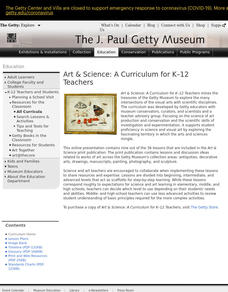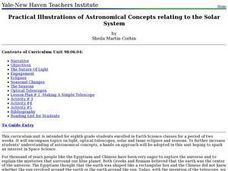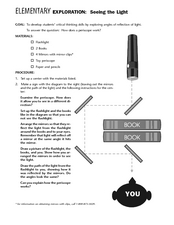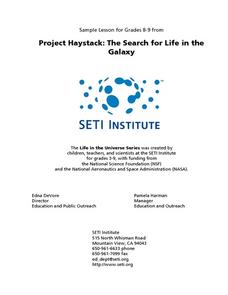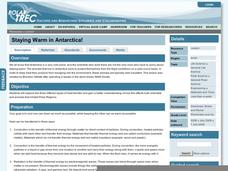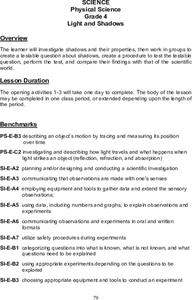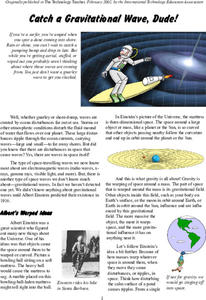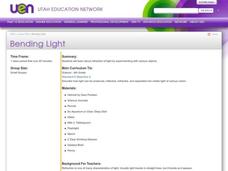Mr. E. Science
Stars, Galaxies and the Universe
It takes 225 million years for our sun to travel around the galaxy. The presentation covers astronomical units, light years, telescopes, types of stars, the life cycle of a star, and types of galaxies. This is the last lesson in a...
American Museum of Natural History
A Closer Look at Mars
A website looks at how we know so much about Mars—telescopes, robots, and spacecraft—and the search for martian life. Following the informational text are three questions that quiz pupils about possible life on Mars.
PHET
Band Structure
Electricity travels at the speed of light, 186,000 miles per second. Through a simulation, classes see how the structure of energy bands in crystals of atoms determines how materials conduct electricity. Participants can change the...
Curated OER
Capturing Light: The Science of Photography
Students create their own cameras to understand how artists use light to capture an image in a photograph. In this light lesson plan, students use tape, wax paper, rubber bands, and more to create their cameras.
Curated OER
TE Lesson: Navigating at the Speed of Satellites
Learners study the basic concepts of the Global Positioning System and how it increases the accuracy of navigation. They examine trilateration and how the speed of light is used to calculate distances.
Curated OER
Practical Illustrations of Astronomical Concepts Relating to the Solar System
Eighth graders are introduced to concepts related to the Solar System. In groups, they participate in an experiment in which they must describe a ray of light and how it travels. They draw a diagram of the electromagnetic spectrum and...
Curated OER
Biotechnology: Drug Delivery and Diffusion
Learners discover advances in biomedical technology such as transdermal delivery and other non-invasive procedures. In lab activities, they examine how medication is given and how molecules travel, observe electrophoresis, and conduct...
Curated OER
Breaking It Down
Seventh graders explain the mechanism of digestion. In this biology instructional activity, 7th graders perform an iodine test to check for the presence of starch. They discuss how energy travels through the food chain.
Curated OER
Un Séjour à Paris
Everyone dreams of going to Paris! Challenge your advanced French speakers to really get to know the city of lights. They use the plethora of worksheets provided to really explore the monuments, museums, and shops of Paris. They use a...
Curated OER
Let's Light Up a Light Bulb!
Third graders investigate the concept of how electricity works in the lighting of a light bulb. They construct a circuit in order to follow the path of electricity and test how it can travel in a wire system. Then the light bulb is lit...
Curated OER
Light and Angles
Students work together in groups to test light and how it reflects at different angles. They create their own hypothesis and answer questions given to them by their teacher. They complete the experiment at home and test if it changes the...
Curated OER
Elementary Exploration: Seeing the Light
Students use critical thinking skills to learn about light, sound, and matter. Students follow the procedure steps to complete a light, sound, and matter experiment.
Curated OER
Me And My Shadow
Students investigate the concept of a shadow. They design a tool to create shadows for an experiment. They make observations and record the size and shape of shadows. The lesson contains background information for the teacher to deliver...
Discovery Education
Sonar & Echolocation
A well-designed, comprehensive, and attractive slide show supports direct instruction on how sonar and echolocation work. Contained within the slides are links to interactive websites and instructions for using apps on a mobile device to...
Curated OER
How Long Would It Take To Travel To the Stars?
Students consider the amount of time that it would take to get to the star, Sirius using various modes of transportation, some practical and some whimsical. The practicality of physically going to another star system is explored in this...
Curated OER
Frozen Film
Students are introduced to the topic of light interference through this hands-on activity. They observe how light reflects off two surfaces and then meets to form an interesting variation of color on a film surface.
Polar Trec
Staying Warm in Antarctica!
Has your class ever wondered how animals and scientists stay warm in the Polar Regions? Kids will investigate to understand the three types of heat transfer and how heat transfer affects those trying to stay toasty in sub-zero...
Curated OER
Light And Shadows
Fourth graders explore the properties of shadows. In pairs they trace each other's shadows in chalk and re-draw their shadow outlines every three hours, design their own shadow investigation, and complete various worksheets related to...
NASA
Catch a Gravitational Wave, Dude!
It is cowabunga time! Pupils read an article about the NASA LISA mission on gravitational waves and conduct additional research on them. The class participates in a science bowl type competition about gravitational waves. Panels of four...
Curated OER
Bending Light
Sixth graders read Hatchet by Gary Paulsen, discuss refraction, identify example of it from novel, and perform classroom experiments demonstrating refraction and reflection.
Curated OER
All Those Seeing Color, Say Eye!
Students discuss feelings and explore how to recognize how they are feeling. In this exploratory instructional activity students discuss conflict and ways to resolve problems.
Curated OER
Color Combinations
Students develop a basic understanding of how color is perceived by the eye. They utilize the technique Seurat used to paint A Sunday on La Grande Jatte to create their own paintings.
Curated OER
Factor Conversion
In this factor worksheet, learners practice doing factor conversions of time, length, speed, and weight. This worksheet has 12 word problems to solve.
Curated OER
Seeds! What is Inside; How does it Grow and Why is it Important?
Students discover the importance of seeds in relationship to nature. In this plant growth lesson plan, students create a collection of seeds and discover the best type of environment to plant them. Students plant their own...





